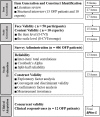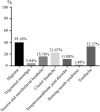Development, validation and psychometric evaluation of the Chinese version of the biopsychosocial impact scale in orofacial pain patients
- PMID: 36960011
- PMCID: PMC10029920
- DOI: 10.3389/fpsyg.2023.1101383
Development, validation and psychometric evaluation of the Chinese version of the biopsychosocial impact scale in orofacial pain patients
Abstract
Background: The objective of this study was to develop the Chinese version of the biopsychosocial impact scale (BPIm-S) to assess functional limitation and psychosocial distress in orofacial pain (OFP) patients in mainland China, and investigate the factor structure, reliability and validity, measurement invariance, as well as scores differences across genders, age and educational status among OFP patients.
Methods: The BPIm-S was developed and evaluated in four stages: (1) concept selection and item generation; (2) a pilot study assessing face and content validity; (3) the factors structure, reliability, convergent validity, and measurement invariance; and (4) concurrent validity and clinical responsiveness. Exploratory (EFA) and confirmatory factor analyses (CFA) were performed on data gathered from 406 OFP patients to assess construct validity. Composite Reliability (CR) and the Average Variance Extracted (AVE) were used to assess internal convergent validity. CR, internal consistency, and split-half reliability were also performed to determine the reliability. Multigroup CFA (MGCFA) was used to assess measurement invariance across genders, age and educational status. Mann-Whitney test compared scores across different genders, age and educational status. Participants completed the BPIm-S, visual analog scale (VAS), brief pain inventory facial (BPI-F), General Anxiety Disorder-7 (GAD-7) and Patient Health Questionnaire-9 (PHQ-9), and spearman's correlation coefficient was used to evaluate the concurrent validity and item-total correlations. A total of 12 patients with OFP completed the BPIm-S twice to test clinical responsiveness. To conduct the CFA and measurement invariance analysis, Mplus 8.4 was used. IBM SPSS Statistics 21 software and SPSSAU, a web-based data science algorithm platform tool, were used for all additional studies.
Results: For the preliminary version, 17 items were chosen. A total of four items were removed following the pilot research. The remaining 13 items of the BPIm-S comprised an overall summary scale. Excellent reliability (Item-to-total correlations ranged from 0.763 to 0.912) and strong internal consistency (Cronbach's α = 0.970, functional limitation, 0.962, and psychosocial distress, 0.977) were discovered. CFA also validated the structural validity of the 13-item scale. EFA was performed and a two-factor structure was investigated. In addition, MGCFA corroborated the measurement invariance of the BPIm-S across gender, age, and educational status. Patients over the age of 30, those with a medium level of education, and those with a low level of education showed substantially greater levels of functional limitation and psychological distress (Wilcoxon test, p < 0.001). Both concurrent validity and clinical responsiveness were assessed to be of good quality.
Conclusion: The BPIm-S demonstrated good psychometric qualities and is a reliable tool that can now be used by clinicians to evaluate functional limitation and psychosocial distress among OFP patient.
Keywords: Chinese patients; chronic orofacial pain; clinical responsiveness; factor analysis; measurement invariance; scale development.
Copyright © 2023 Ou-Yang, Feng, Xie, Yang, Chen, Chen, Su, Kuang, Zhao, Zhao, Feng and Guo.
Conflict of interest statement
The authors declare that the research was conducted in the absence of any commercial or financial relationships that could be construed as a potential conflict of interest.
Figures
References
-
- American Psychiatric Association (2013). Diagnostic and statistical manual of mental disorders: DSM-5, Vol. 5. Washington, DC: American psychiatric association.
-
- Bonett D. G., Wright T. A. (2015). Cronbach’s alpha reliability: Interval estimation, hypothesis testing, and sample size planning. J. Organ. Behav. 36 3–15.
LinkOut - more resources
Full Text Sources




